The Audemars Piguet Calibre 4400, the New In-House, Integrated Chronograph
Finally here, meet AP's new in-house, integrated chronograph movement, launched in the ambitious Code 11.59 collection.
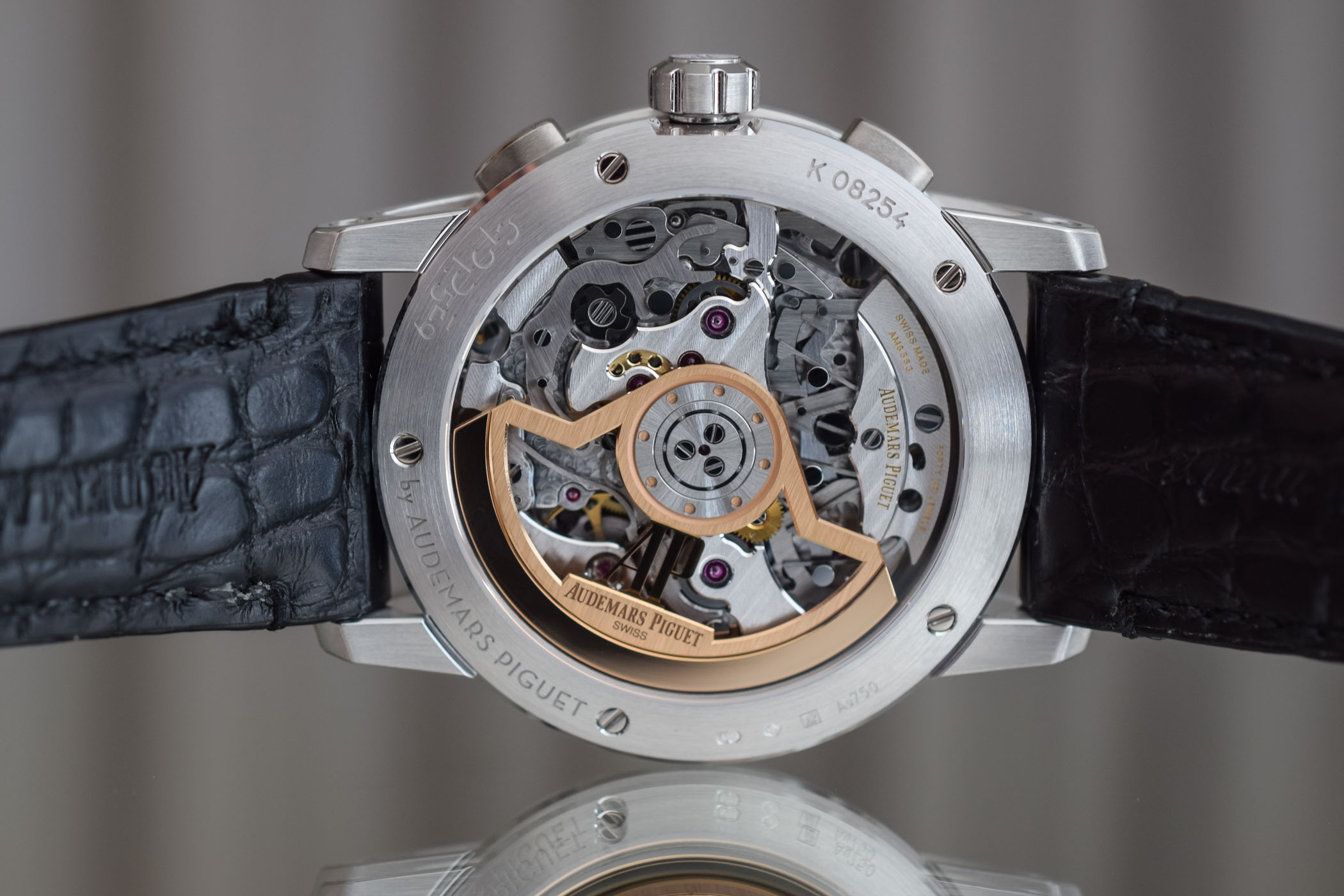
The launch of the Code 11.59 collection is a crucial moment for Audemars Piguet. There has been no product launch of this magnitude over the past 20 years for the brand. In this respect, the Code collection presentation was the perfect opportunity to introduce a long-anticipated development that was announced a few years ago: the Audemars Piguet Calibre 4400, an in-house, integrated chronograph movement – by no means a small achievement since chronographs are extremely difficult to develop.
Long awaited, finally here!
Until now, Audemars Piguet has manufactured a few high-end chronographs in-house in the Le Locle APRP manufacture. However, the brand relied mostly on outsourced chronograph movements – either integrated with the Piguet-based FP1185, or modular with Dubois-Depraz modules on top of the in-house 3120 Calibre. At last, the long-awaited Audemars Piguet in-house, integrated chronograph is now here!
The Audemars Piguet Calibre 4400 chronograph is a high-end, modern chronograph that has been five years in the making. Its construction focusses on performance and efficiency, and it incorporates several interesting technical specificities. The development started just a few months after the appointment of François-Henry Bennahmias as CEO of the brand. In 2013, Bennahmias gathered his product and production teams, literally locking them in a meeting room and stating, “nobody leaves the room until we have agreed on the key options and laid the foundation for the development of a chronograph movementâ€.
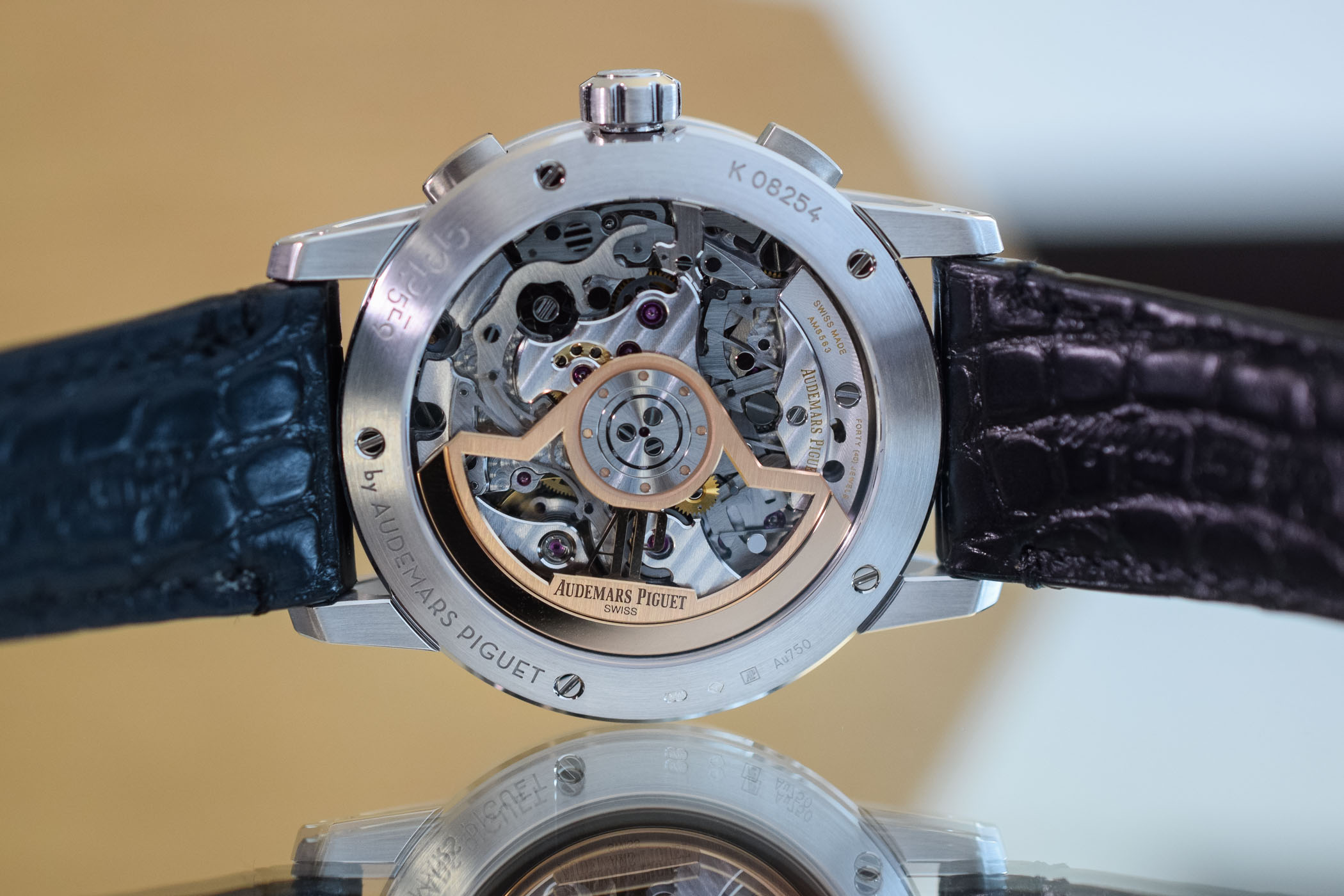
Following this mandate, Audemars Piguet developed not one but two movements, both 14’’’ in diameter and part of the same family:
- The AP 4300, an automatic base calibre – used in its AP 4302 variant in the Code collection
- The AP 4400, an automatic, integrated flyback chronograph – used in its AP 4401 variant in the Code collection
Naturally, both movements have a lot in common and share several components. They utilize the same barrel, the same regulator and common parts for the keyless works or wheel train. The look and feel are familiar with that of the previous Audemars Piguet movements, in particular with the design of the bridges.
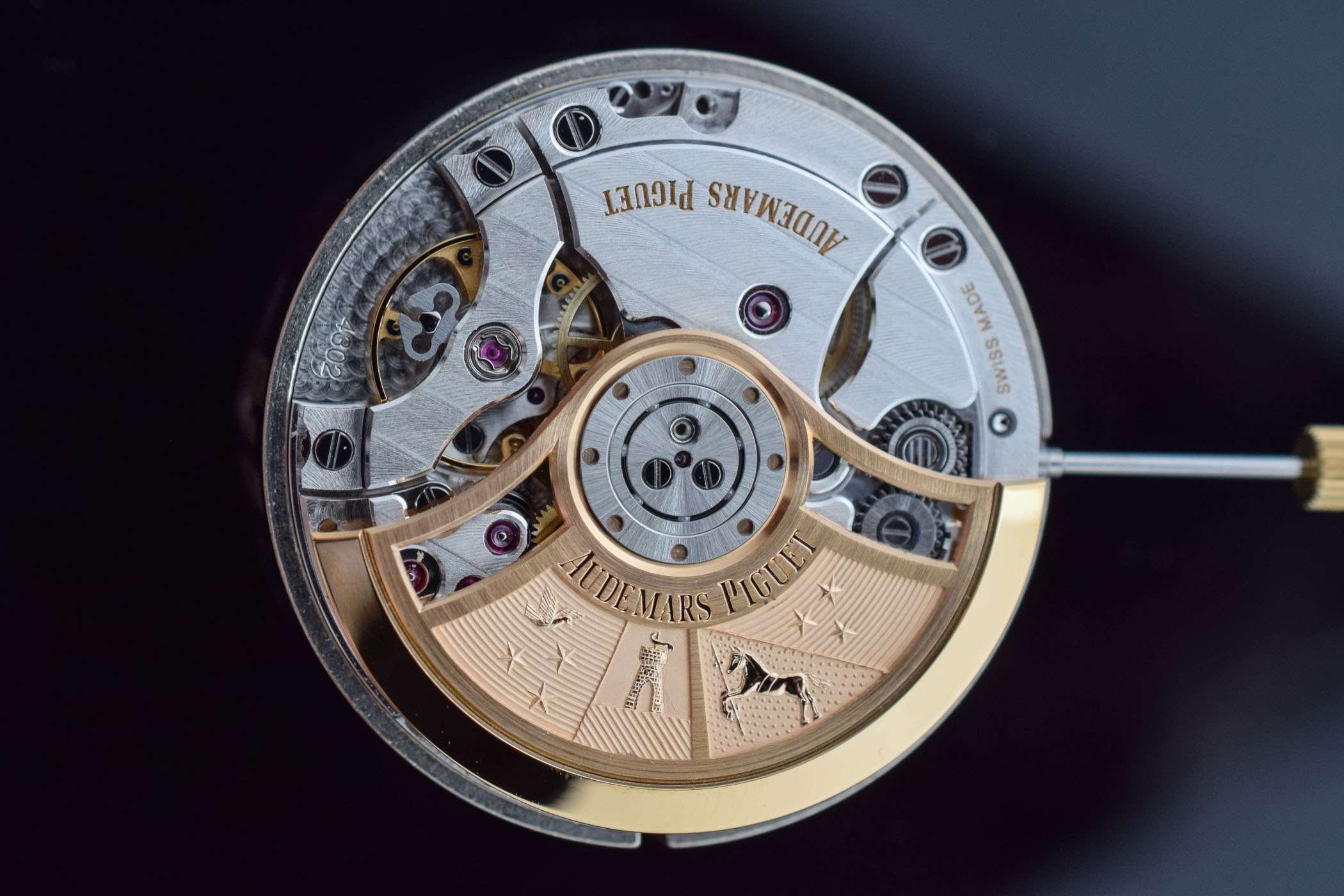
Chronometric precision was a key factor in the development of these two calibres. For enhanced stability, Audemars Piguet has opted for a transversal balance bridge rather than a balance cock. On each side, there is a screw to adjust the balance end shake. The oscillator operates at 28,800 vibrations per hour. The large balance wheel has an inertia of 12.5 mg/cm2Â to provide optimal stability. It features 3 harms and 6 adjustment weights. The large barrel ensures a healthy 70-hour power reserve. Winding is bi-directional thanks to two reversers with ball bearings – a comparable system was already used by Audemars Piguet for the AP4101 Calibre.
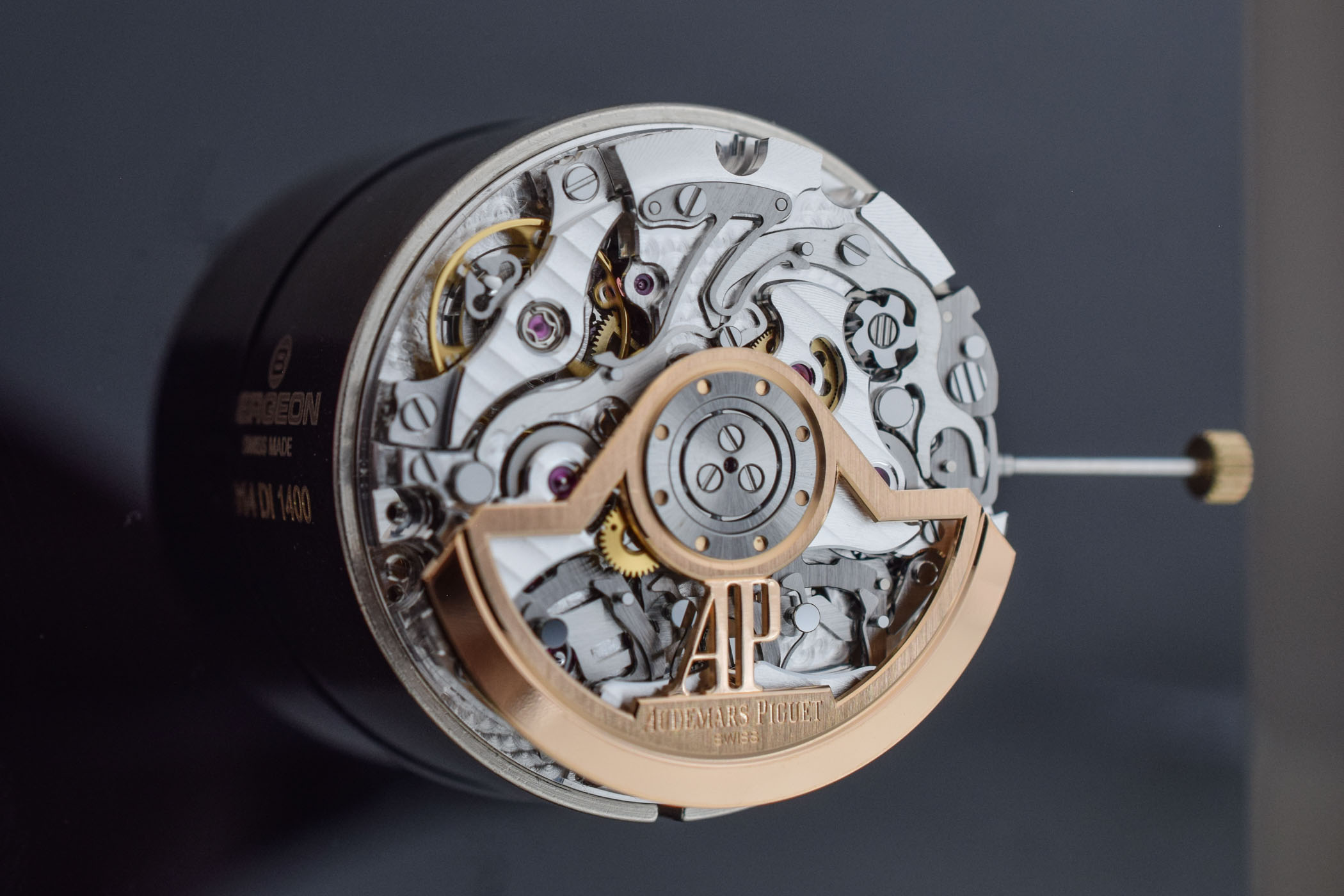
If the crown/stem operation is traditional (Position 1 for manual winding, P2 for quick date setting set, P3 for time setting), the keyless works integrate a smart patented solution. An oscillating pinion drives the selection of the function. When the crown is pulled, a wheel (that becomes inclined!) engages with the date correction wheel or the time correction wheel. This architecture avoids any backlash when pushing the crown back in.
The Calibre 4400
The Chronograph Calibre 4400 is a high-end, modern construction with a focus on performance and efficiency. This large movement (32mm) is an integrated construction with a column-wheel and vertical clutch.
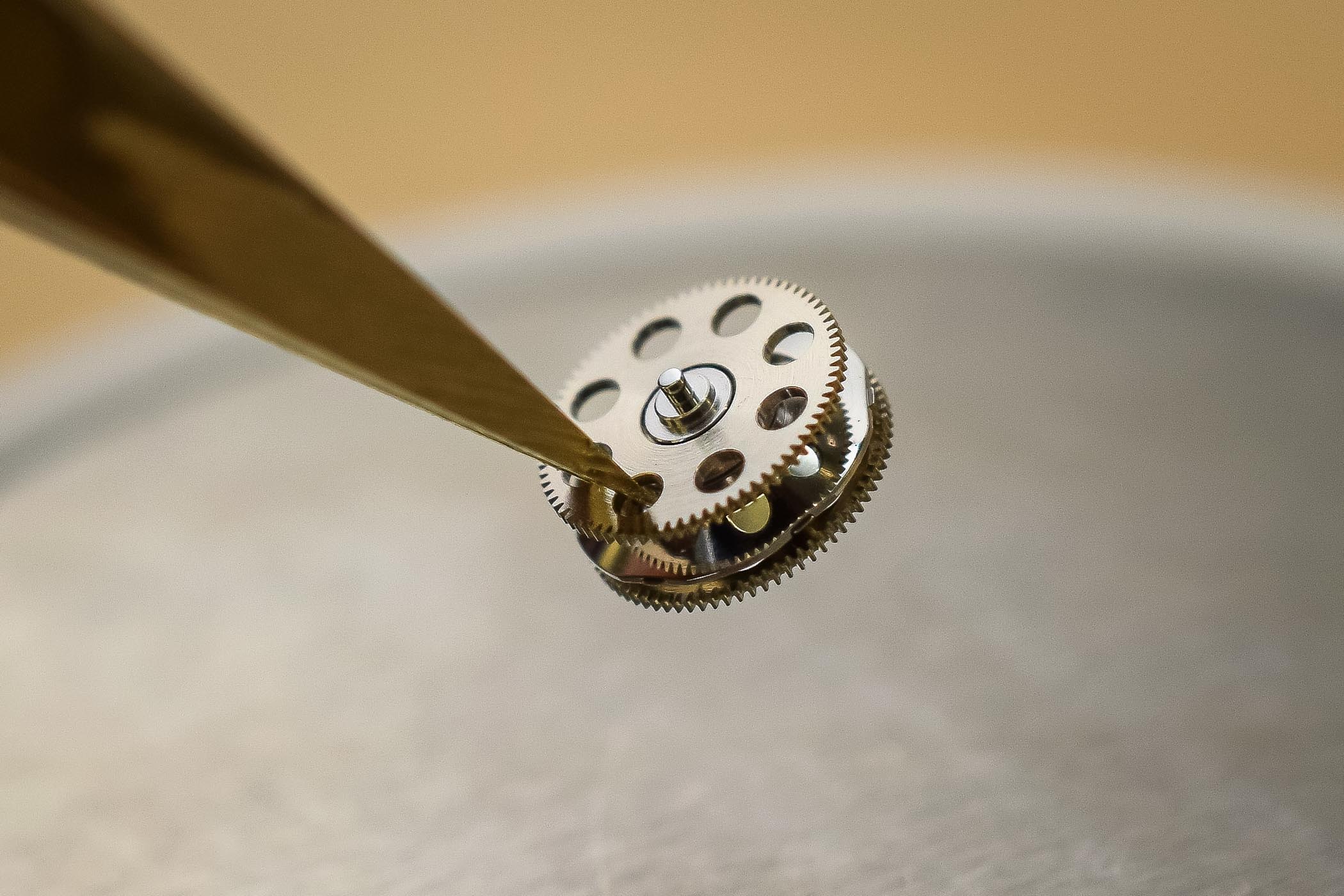
Coupling – A solution found in most modern chronographs, the vertical clutch enables absolutely precise starts and stops. As its name indicates, the connection of the chronograph mechanism with the timekeeping gear train is executed vertically and by friction, similar to the systems found in automobiles. The theoretical advantages of vertical clutch chronographs are that there are no teeth to engage or disengage, a principle that may cause the jump of the chronograph seconds hand when the teeth mesh.
When you stop the chronograph, you disengage the drive train from the chronograph mechanism. At the same time, brakes are applied on the hour and minute recorders while the chronograph seconds feature a friction mechanism.
Start-Stop-Reset – One of the first things to catch your eye on the Calibre 4400 are the three twin hammers and hammer springs. The hammers are responsible for resetting the hands. When the brakes are lifted, the hammers fall on heart-shaped cams rotating these until the hammers come to rest on the two shoulders of the heart and immobilize it.
The three hammer springs are almost identical and positioned one next to the other. Not only is the function smooth and complete but it is really cool to see these in action one next to the other, which is superbly highlighted by the architecture of the movement.
Flyback chronograph -Â The AP 4400 is a flyback chronograph, which means it can be returned to zero and restarted instantly with a single push of the button. This function allows rapid retiming without the need for pressing pushers three times in succession to stop, reset and start the chronograph. But this means extra complexity as the reset must be operated without breaking any part, and the hammers then need to be disengaged to restart the chronograph.

Decoration – Finishings on the Calibre 4400 include straight and circular satin brushing, Geneva stripes and perlage – on both sides of the bridges, even in the hidden areas. The bridges feature large chamfers, perfectly diamond polished. Engravings are gold-toned. The 22K gold rotor is openworked with the AP logo, which offers a superb view of the mechanism.
As with all Audemars Piguet watches, the timepieces equipped with the Calibre 4400 come with a 5-year warranty. For more information, please visit www.audemarspiguet.com.
Audemars Piguet Calibre 4400 – Specs
- Architecture:Â Integrated, automatic, column-wheel and vertical clutch, flyback chronograph
- Dimensions: 32mm x 6.8mm
- Frequency: 28,800 vibrations per hour
- Balance wheel: variable inertia, 6 weights, 12.5 mg/cm2
- Power reserve: minimum 70 hours
- Winding: automatic, bi-directional
- Coupling: vertical clutch
- Jewels: 40
- Functions: hours, minutes, seconds, date, flyback chronograph

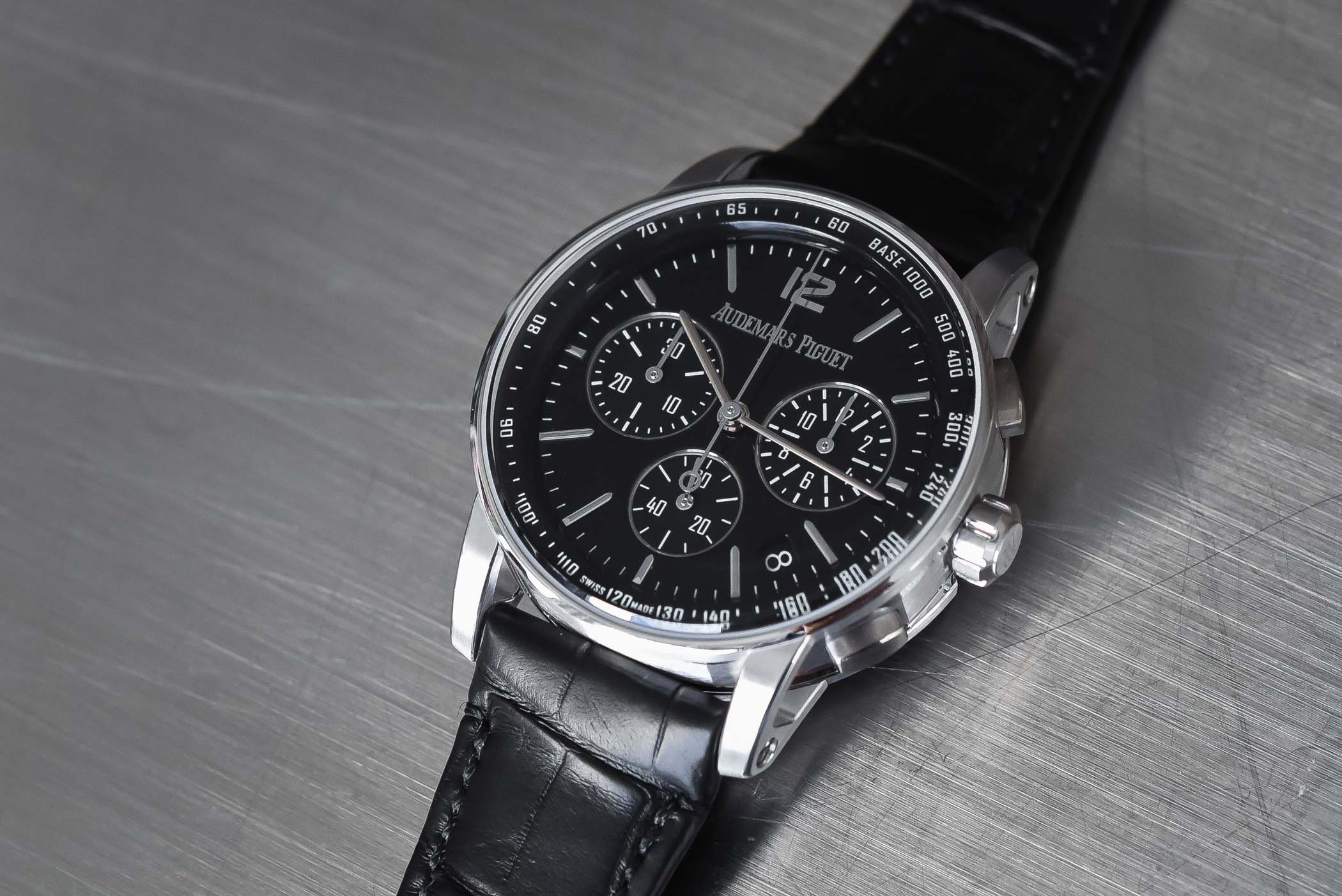
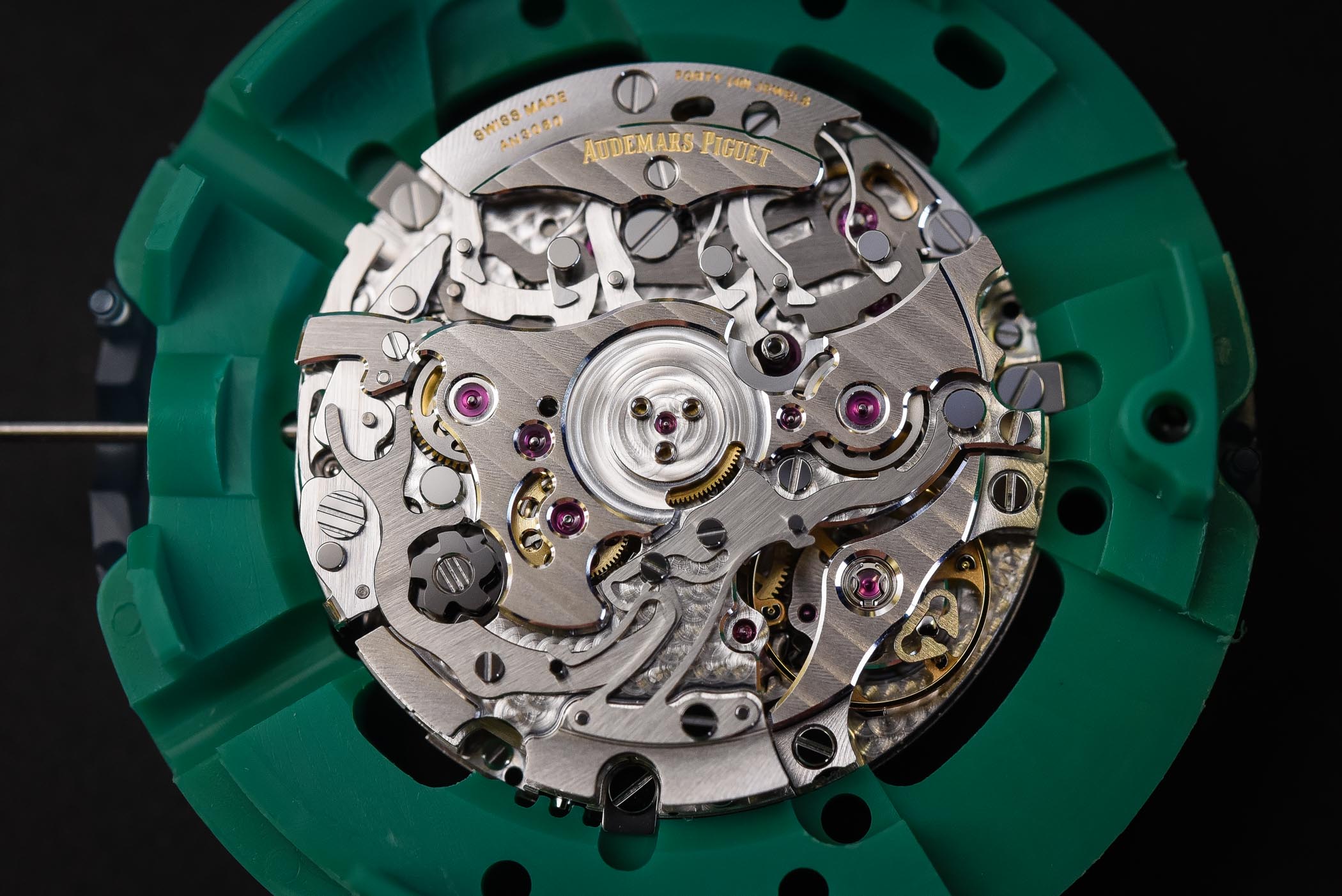
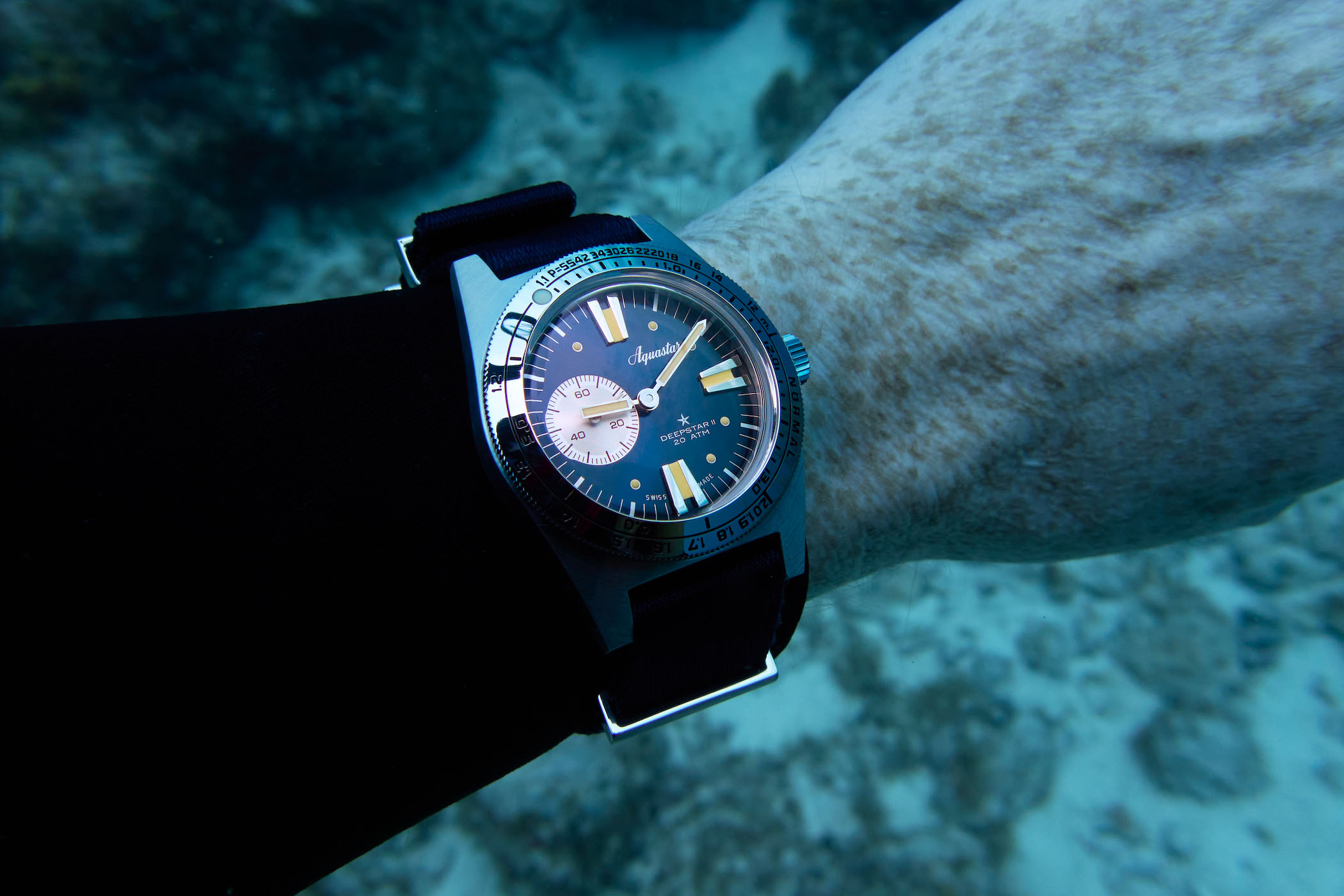
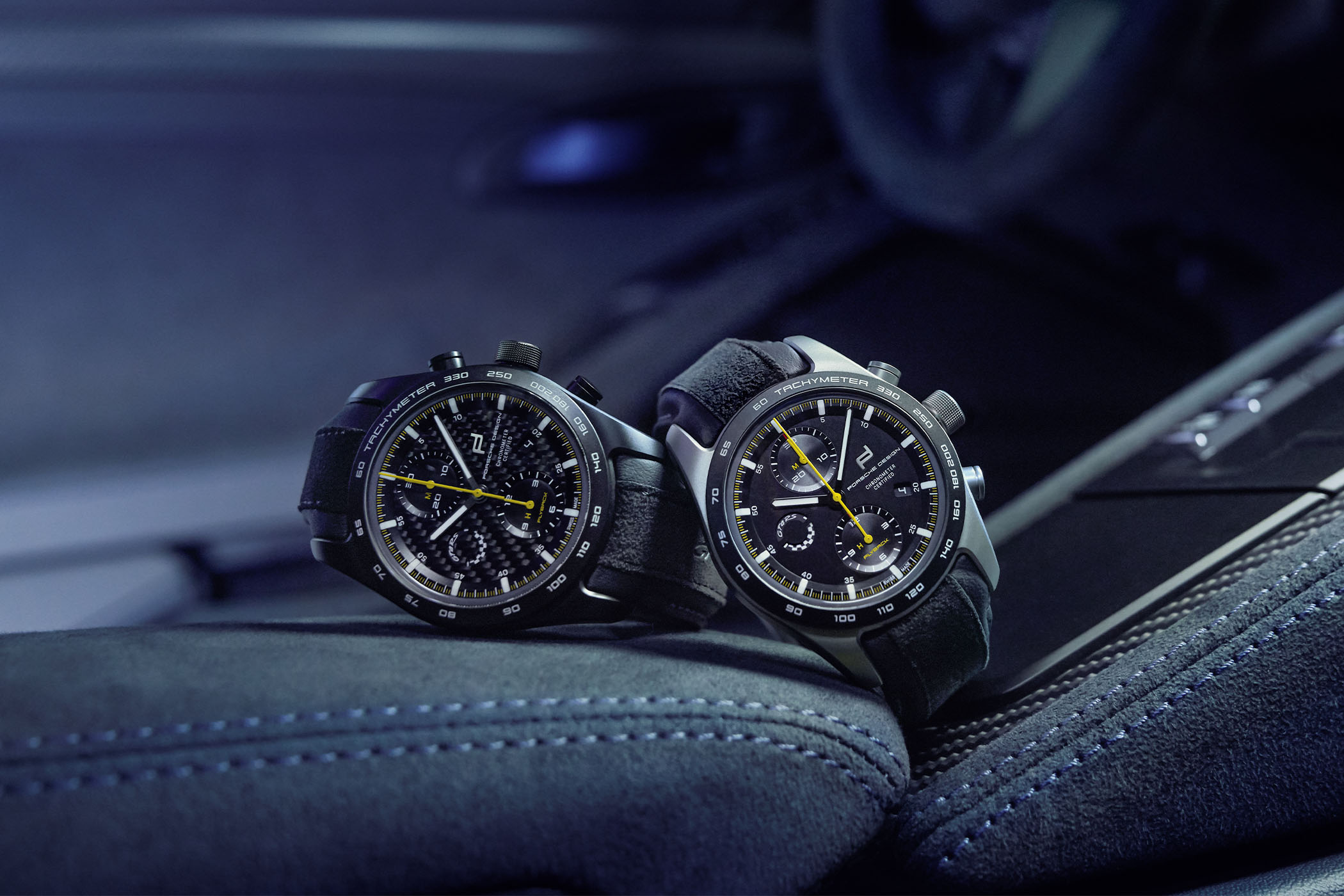
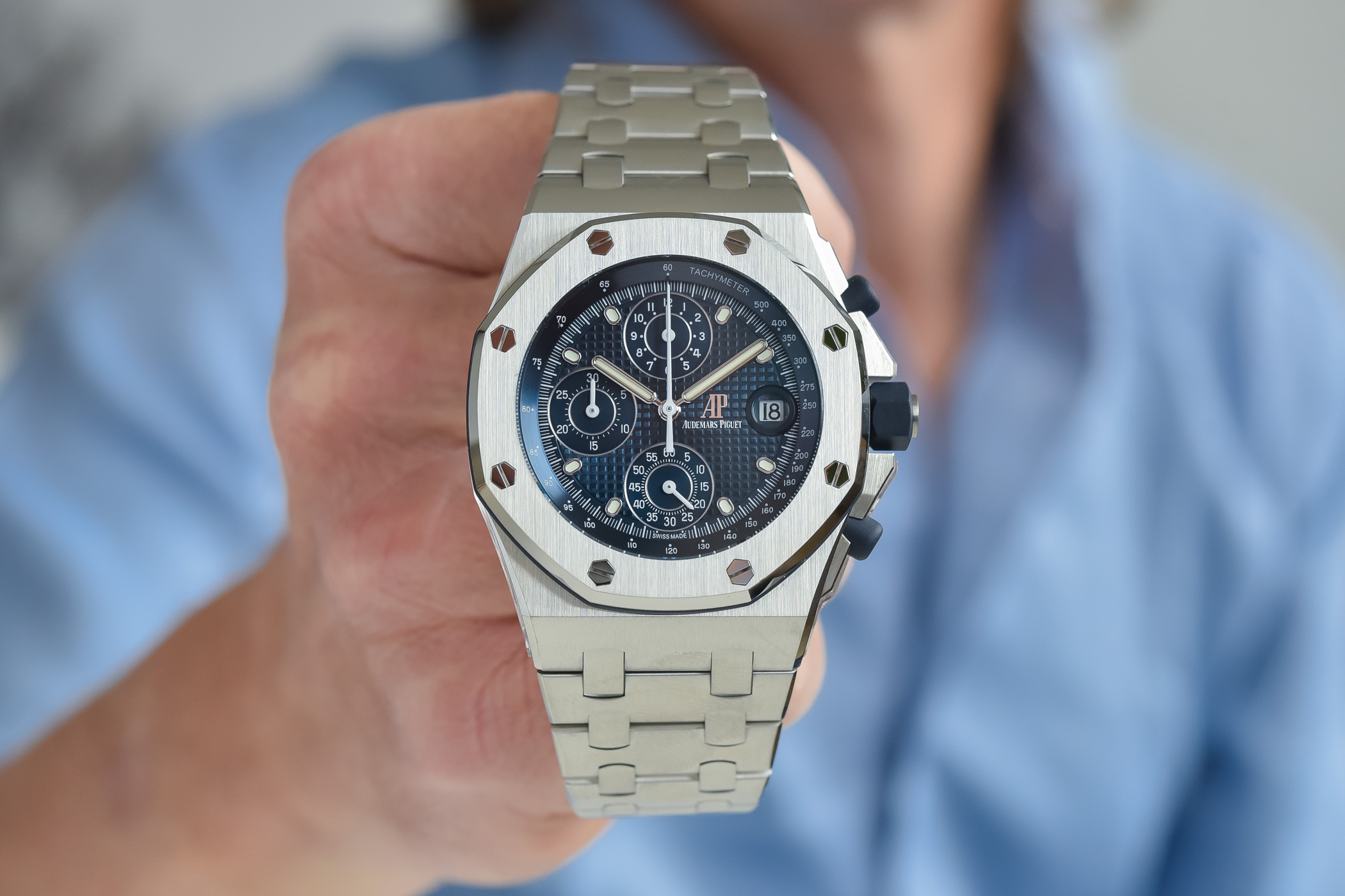
20 responses
Great article, thanks. Monochrome as usual doing great coverage to SIHH 2019.
The finish seems a step inferior to the AP existing movements. The same applies to 4302 as well ,comparing with the 3120. But i have to examine them closely first before i come to a conclusion. The first impression is that they both look too “industrial” for an AP “hand made” movement
Does anyone else find the layout/architecture of the chrono movements not very pretty, too industrial/tool like?
Thanks for the review! Great to see AP with their in-house chrono – a nice, modern movement. Curious to see when it will be used for the RO too.
Very interesting technical coverage of the new calibre, well done.
Also, you guys at Monochrome have had some of the best SIHH coverage this year. Well done to you all!
Pretty exciting stuff. Not sure what the editorial opinion on the dial side is. I’m curious
@GW
Agreed. For me both cal. 4301 and 4401 are unattractive in aesthetics and finishing.
Was this a press release copied straight to the website? It doesn’t offer much detail. Not a word on accuracy, service intervals, price, availability, lubrication, spring material or whether any work is outsourced.
“The large balance wheel has an inertia of 12.5 g/cm2”. Oh really? What exactly is the inertia of other balance wheels? Does that mean that this enormous balance wheel is affected more by gravitational pull? We are told that the crown architecture “avoids backlash”. Avoids or negates? Are other movements “plagued” with crown backlash?
The more I read about this subject, the less certain I am of the engineering merits of spending the astronomical sums asked by the so-called Big Three. Now to be clear, I am not saying that they do not exist. It is just extremely difficult to find the information needed to make a decision about a wristwatch which carries the sticker price of a new car.
@anotherguy No this is not copied from a press release or any other text but thank you for your appreciation. The first watches powered by this movement are available in a few days. The balance spring is conventional not silicon. Service intervals: warranty is 5 years so this might give an idea. Price: AP (my guess) does not plan to sell this movement to third-parties. If you want an idea about the price of watches with this movement, read an article about the code 11.59 collection. Moment of inertia of the balance, not a record (and not presented as such) but something well suited for a large 32 mm caliber. Given the level of vertical integration at AP, expect a large amount of components to be manufactured in-house but not 100% (for instance, I assume hairspring, jewels, mainspring…)
Thank you for replying Xavier. I read monochrome often and I would like to say that the negativity of some of my comments does not (often) come from dissatisfaction with this site in particular, but with The Watch Industry itself. I find myself at a bit of a personal impasse/crossover point, as I am able to afford watches in the “certified classic (non-affordable)” category and I strongly suspect that anything above say a Grand Seiko/Omega/Rolex but under, e.g. a Laurent Ferrier offers few horological advances. However I simply do not have the knowledge to be sure nor can I seem to find it. Would you be able to direct me to online resources which would allow me to educate myself?
If it’s any use at all, JAGOTW, just off the top of my head: Blancpain’s under-lug safe-zone correction system is superb and their Villerets are beautiful; Ulysse Nardin’s backward-winding Perpetual Calendar is a steal considering the complication; and the Breguet Classique 10hz Chronometer with magnetically-suspended balance might just fit into the price range (easy to get from reputable grey market stores).
Thanks Gil. I was in a boutique the other day which stocks Frederique Constant and I am sure they had a perpetual calendar for not a lot of money! But I did just search for the Brugeut 10hz mvt and found an article on the 7727. OK, this is $40K and gold-cased but the movement itself is truly innovative and extremely advanced. This is the kind of thing one can point to as definitely worth spending on. We’ve got balances suspended by magnetic resonance now? WOW. I can’t remember it being heralded from the roof-tops in the watch media. Not like the new Rolex “rootbeer” was. 🙁
Haha, yeah. It won the Aquille D’or in 2014, but I had to dig a bit before I found out about it. It goes for around £25k/£26k on the grey market here in the UK, which I would’ve said was about the $33k mark, but yeah, it’s not cheap. But imagine a high-end independent piece in gold with that marvellous movement and six different types of hand guilloche on the dial, and it doesn’t seem too bad.
You’re probably right about the gulf where one might expect innovation or bleeding-edge tech in certain models around the $20k mark; it’s just that you have to be ready to cough up a great deal more for it. However, I’d love to be proved wrong about that.
@anotherguyontheweb thank you. Well, I think/hope you may find already quite a lot here at Monochrome, may be in the technical guide? The same goes with some of our colleagues. True innovations in watchmaking are rare these days but even a simple three-hander, nicely designed and finely finished can be a real treat…
7727 is a fairly good choice in my view, however it wears quite large on the wrist because of Breguet’s iconic straight lugs.
Yeah those lugs are certainly….iconic. Over the last year or so I have gravitated towards smaller watches, ideally 36-37mm, which limits my choice somewhat. It might seem heretical to mention my Rado Captain Cook under an article announcing a new AP calibre, but powered by the new ETA C07.111, this watch runs at +1s/day on the wrist. This leaves me wondering what will be gained chronometrically by owning far more prestigious movements.
Not a lot, JAGOTW. Just as there’s not much more physical detail to be gleaned from a beautiful painting than can be captured by a high-definition photo.
Btw, what price range do you find yourself in now?
I can afford up to a no-date Submariner but I am put off by Rolex for the usual reasons. Although about a year back I tried on the 36mm blue-dialled OP and immediately I heard a little shrill voice in my head screaming “I can afford a ROLEX!” I am trying to resist that voice. I was about town the other day and managed to track down a GS dealer (the previous Seiko boutique had closed or moved) and they had a 253, the classic 37mm “heritage” model with black dial and black date and I thought “Is there any need to for anything better?” I have to say though, I kind of like the Frederique Constant models I saw. I have spent the last day or so looking at FC reviews and reading user comments, many of which boil down to “Anyone who can’t afford a Patek is a loser”. It seems the level of spite towards FC is high, which almost makes me want to buy one more!
It’s a shame the Grand Seiko Snowflake doesn’t come in a smaller size, as then there’d be no competition.
Well within your range, Habring’s Foudroyante comes in 36mm, and he seems a technical wizard, so I think there might be impressive guts there. Nomos makes some nice models in your desired size, but not sure if you like that Bauhaus style.
I have to say I know next to nothing about Frederique Constant, but if they’re making high quality pieces for a reasonable amount then why not?
Thanks Gil. 🙂